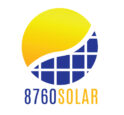
Ever stumbled upon Project Sunroof while researching solar energy? Chances are, you haven’t. Surprisingly, this valuable tool, designed by the creators of the world’s largest search engine, often stays under the radar.
Although the tool has a few drawbacks, it’s still highly useful to any homeowner considering solar energy. At the very least, it’s fun to use and brings up loads of interesting projections and statistics.
We’ve given it a thorough testing, so here’s the lowdown of what Project Sunroof is and what you can do with it.
In a Nutshell
- Project Sunroof uses digital surface modeling, 3D imaging, and various datasets to determine how much sunshine a homeowner’s roof receives throughout the day.
- The tool provides additional data, including how much of the roof’s surface can be used for solar, what the return on investment will be, and the projected costs and financing options for the project.
- Project Sunroof is a good way to get an idea of costs and benefits, but it’s not a substitute for a quote from a solar developer.
- The tool is only good for roof-mounted solar installations and it hasn’t been updated since 2018.
- The tool provides interesting insights into Colorado’s solar potential and concludes that 87% of the state’s roofs can host solar panels.
What Is Project Sunroof?
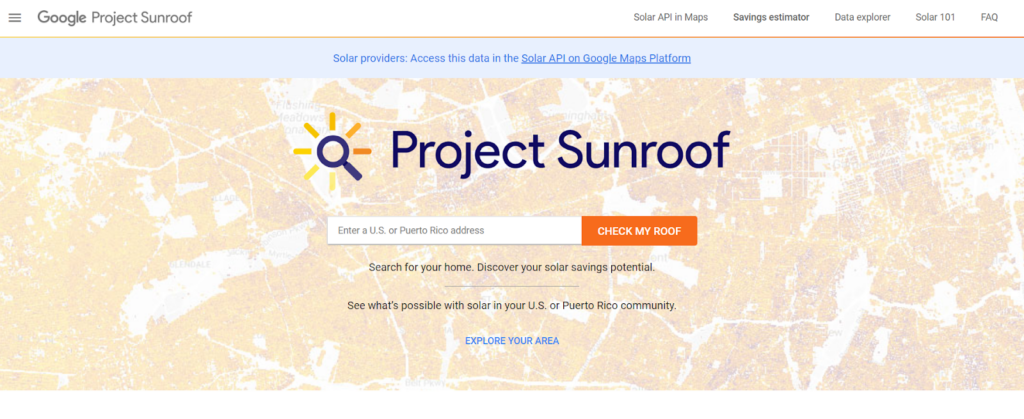
Owned by Google, Project Sunroof was the brainchild of a Google engineer, and has been in existence since 2015.
It consists of a clever online calculator that homeowners can use to determine how much they will benefit from solar energy and whether or not it’s worth installing. The calculator uses multiple data sets, including Google Earth imagery, solar pricing data, solar incentive data, and more to make its predictions.
Here’s where it gets impressive.
The imagery generated from Google Earth creates a digital surface model of a homeowner’s roof and surrounding area. This tells the system which direction the roof is facing and whether or not there are shade-creating objects nearby, such as trees or other buildings.
By combining these images with machine learning and clever 3D modeling, it is able to determine how much sunlight hits the roof throughout the day.
To provide an even higher level of accuracy, the tool also incorporates average local weather pattern data taken from the National Renewable Energy Laboratory (NREL).
To provide an even higher level of accuracy, the tool also incorporates average local weather pattern data taken from the National Renewable Energy Laboratory (NREL).
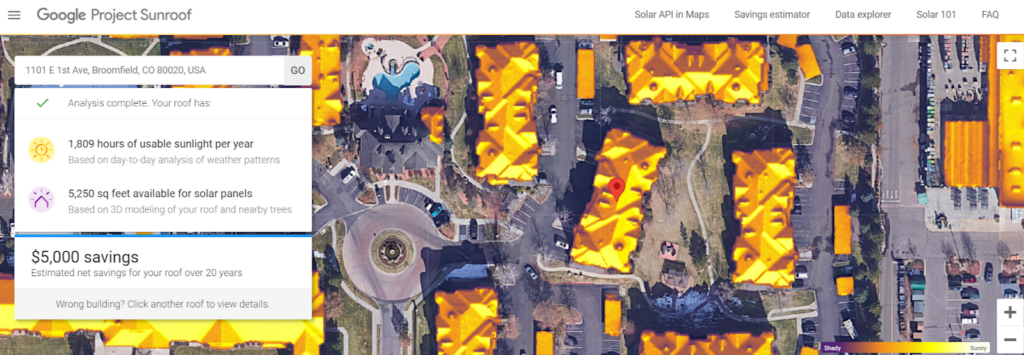
With everything combined, Project Sunroof provides a realistic estimate of how much energy a solar system will produce along with how much roof space is suitable for roof panels.
It will also tell you how much you can save on your energy bills over the next 20 years as well as your recommended solar installation size based on the cost of your monthly energy bills.
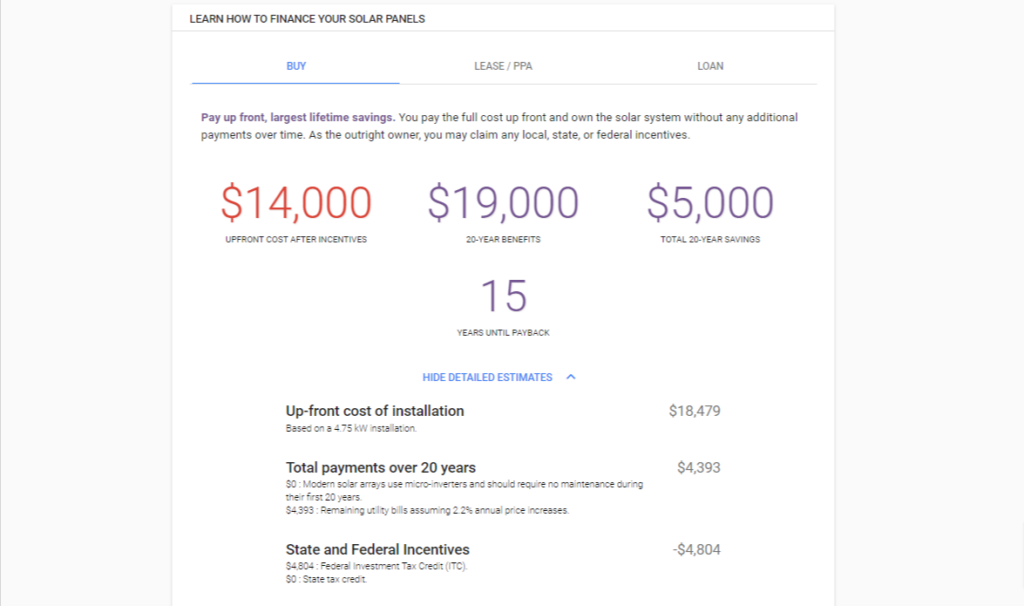
Lastly, the tool will give you financing options and the projected costs of the solar system, including any federal incentives and in what year you will see a full return on your investment.
Why Use Project Sunroof?
Project Sunroof provides fast and easy access to the data that matters. Since solar installations are always bespoke, there is not a one-size-fits-all to pricing. Furthermore, solar developers can’t access the technology that Google possesses, so it’s impossible for them to provide upfront pricing without first carrying out an analysis of the property.
Additionally, there’s nowhere else online where you can find tailored insights into how much a household can save on their energy bills, the size of the required system, and so on.
In this day and age, consumers want information fast. Nobody wants to wade through dense research or crunch numbers. That’s where Project Sunroof shines. It’s a game-changer, making solar energy more accessible and appealing. After all, the more people that embrace solar, the brighter our planet’s future becomes.
What Are the Downsides of Using Project Sunroof?

As with all technology, no matter how smart it is, there are always a few downsides.
First of all, the technology does not cover the entire USA. Currently, you can find data for over 60 million roofs across 50 states, but the last entry in the tool’s changelog was in 2018, meaning it hasn’t been updated since then.
The other obvious problem with this tool is that it’s for roofs only. This makes it unsuitable for many businesses, particularly farms and agricultural businesses that are more likely to use ground-mounted solar arrays rather than roof-mounted.
We will add here, however, that the tool does include flat roofs, so it can predict solar benefits for many commercial buildings.

Another hitch we found when using the tool is that it has the tendency to group attached roofs together.
Looking at the example image above, we can see by the numerous parking spaces and access roads and paths that the highlighted roof probably covers a group of attached houses, or apartments that are unlikely to be owned by the same person.
If you live in an attached residence, this is going to make it very difficult for you to understand your individual solar benefits and costs.
Using Project Sunroof for Colorado Data

One really cool aspect of this tool is the ability to select a wider area or entire state and view its estimated solar potential. Of course, we couldn’t resist looking at what Colorado has to offer!
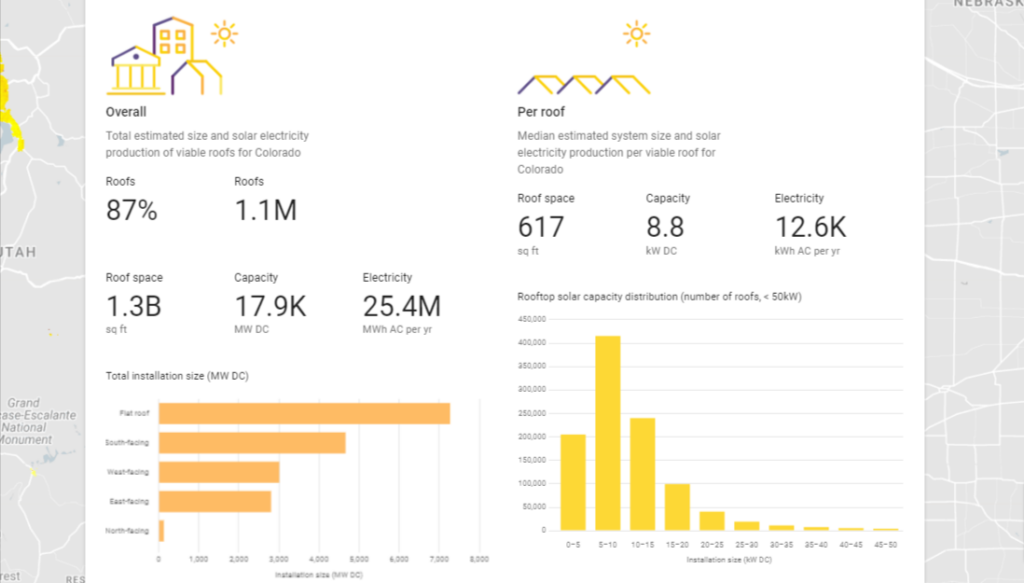
The data it generated was really interesting. The tool states that it currently has data for 58% of Colorado’s roofs, so we’re looking at a little over half the state’s solar potential here.
The data revealed that:
- 87% or 1.1 million of Colorado’s roofs are viable for solar energy
- There is 1.3 billion square feet of available roof space for solar
- The average Coloradan roof offers 617 square feet of space which will accommodate an 8.8 kWh solar system generating 12.6 kW of AC electricity per year
- The state has a lot of flat roof space available to accommodate solar energy

Further down the page we can view the impact if all viable solar installations were implemented. If this happens, Colorado will enjoy a reduction of 19.6 million metric tonnes of carbon dioxide! This is equal to 4.3 million cars worth of emissions per year or ten years’ worth of growth of 327 million trees. Pretty incredible stats!

Finally, the tool lists some of Colorado’s top energy providers and the solar incentives they provide, along with convenient external links for readers to learn more.
Project Sunroof: Conclusion
In conclusion, Project Sunroof is a great tool for homeowners who want to understand more about the costs and benefits of solar installations and financing options before they approach a solar developer.
Our concern, however, is that it has not been updated since 2018, and many of the financing options and solar incentives may have changed since then.
Therefore, we recommend that users of the tool take the information it provides with a grain of salt and always keep in mind that this information is not a substitute for an actual quote from a solar developer.
Additionally, we would also love to see the tool expanding to include land space such as fields. This would go a long way toward getting more businesses – particularly agricultural businesses – more interested in the potential of solar.
To get an accurate farm or agricultural business solar energy quote – whether roof or ground-mounted – talk to our team at 8760 Solar. To get started, text “READY” to 719 470-0254 or via email: sales@8760solar.com.
Frequently Asked Questions
What Is Project Sunroof Used for?
Project Sunroof is a tool developed by Google to show homeowners how much they can benefit and save from roof-mounted solar panels. Additionally, it provides a cost breakdown of the projected solar system’s size and details the available financing options.
Who Is Project Sunroof for?
Project Sunroof is aimed specifically at homeowners who want to understand more about the cost and benefits of installing solar panels on their roofs.
Is Project Sunroof Any Good?
Project Sunroof is an excellent tool for providing insight into the costs and advantages of solar energy. However, it is limited to roof-mounted installations only, which makes it unsuitable for businesses that want ground-mounted solar systems.
Is Project Sunroof Accurate?
Project Sunroof can provide a good ballpark figure for the cost of a home solar system, but it should not be considered a substitute for a quote from a certified solar developer. Also keep in mind that the tool has not been updated since 2018, so much of its data may be inaccurate by now.
What Is the Project Sunroof Methodology?
Project Sunroof uses digital surface models, 3D imaging, and a series of datasets like average weather patterns to determine the amount of direct sunlight a roof receives in a day as well as how much shade there is.
